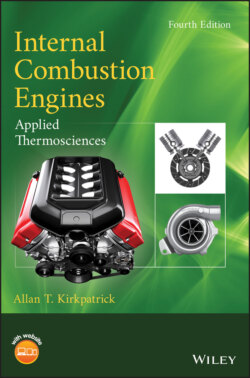Читать книгу Internal Combustion Engines - Allan T. Kirkpatrick - Страница 52
2.6 Miller Cycle
ОглавлениеThe efficiency of an internal combustion engine will increase if the expansion ratio is larger than the compression ratio. There have been many mechanisms of varying degrees of complexity designed to produce different compression and expansion ratios, and thus greater efficiency. The Miller cycle was patented by R. H. Miller (1890–1967), an American inventor, in 1957. It is a cycle that uses early or late inlet valve closing to decrease the effective compression ratio, and allowing a higher geometric compression ratio (Miller 1947).
This cycle has been is used in ship diesel engines since the 1960s, and has been adopted by a number of automotive manufacturers for use in vehicles. A 2.3 L supercharged V‐6 Miller cycle engine was used as the replacement for a 3.3 L naturally aspirated V‐6 engine in the 1995 Mazda Millennia. This engine used late inlet valve closing at 30 after the start of the compression stroke. The 2017 3.0 L turbocharged Audi V‐6 uses early inlet valve closing, which also effectively creates a smaller compression ratio.
The Miller gas cycle is shown in Figure 2.7. In this cycle as the piston moves downward on the intake stroke, the cylinder pressure follows the constant pressure line from point 6 to point 1. For early inlet valve closing, the inlet valve is closed at point 1 and the cylinder pressure decreases during the expansion to point 7. As the piston moves upward on the compression stroke, the cylinder pressure retraces the path from point 7 through point 1 to point 2. The net work done along the two paths 1‐7 and 7‐1 cancel, so that the effective compression ratio = / is therefore less than the expansion ratio = / .
Figure 2.7 The Miller cycle.
For late inlet valve closing, a portion of the intake air is pushed back into the intake manifold before the intake valve closes at point 1. Once the inlet valve closes, there is less mixture to compress in the cylinder, and thus less compression work.
Performing a first‐law analysis of the Miller cycle, we first define the parameter, , the ratio of the expansion ratio to the compression ratio:
(2.34)
The energy rejection has two components
(2.35)
As detailed in Example 2.2 below, the thermal efficiency is
(2.36)
Equation (2.36) reduces to the Otto cycle thermal efficiency as . Also detailed in Example 2.2, the imep is
(2.37)
The thermal efficiency of the Miller cycle is not only a function of the compression ratio and specific heat ratio but also a function of the expansion ratio and the load . The ratio of the Miller cycle thermal efficiency to an equivalent Otto cycle efficiency with the same compression ratio is plotted in Figure 2.8 for a range of compression ratios and values. With values of and , the Miller cycle is about 20% more efficient than the Otto cycle.
Figure 2.8 Ratio of Miller to Otto cycle thermal efficiency with same compression ratio, ().
The ratio of the Miller/Otto cycle imep is plotted as a function of in Figure 2.9. As increases, the imep decreases significantly, since the fraction of the displacement volume that is filled with the inlet fuel–air mixture decreases. This relative decrease in imep and engine power is a disadvantage of the Miller cycle, which is the reason supercharging of the inlet mixture or increase of the overall engine displacement volume is used to increase the imep.
Figure 2.9 Ratio of Miller to Otto cycle imep with same compression ratio, ().
A related cycle, the Atkinson cycle, is one in which the expansion stroke continues until the cylinder pressure at point 4 decreases to atmospheric pressure. This cycle is named after James Atkinson (1846–1914), an English engineer, who invented and built an engine he named the engine in 1889. This engine had a two‐bar linkage between the connecting rod and the crankshaft so that the piston traveled through four unequal strokes in every crankshaft revolution. The expansion to intake stroke ratio was 1.78:1. Honda (Takita et al. 2011) has recently produced an Atkinson cycle engine by adding a trigonal link, swing rod, and eccentric shaft to a conventional connecting rod and crankshaft assembly. The engine is used in a micro combined heat and power generation (CHP) application. The engine , with an expansion ratio and compression ratio of . The brake thermal efficiency is 26.3% compared to 22.5% for a conventional engine.
